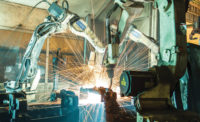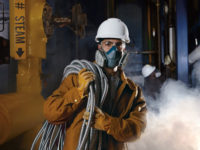Digital Edition Exclusive
Get your hands on the right safety gloves
Safety gloves, correctly sized and engineered with the correct materials, defend workers from virtually any type of hazard

According to the U.S. Department of Labor, injuries to hands accounted for nearly 25 percent of all lost-time industrial injuries - a total of 110,000 annually. Seventy percent of those injuries resulted when an employee was not wearing safety gloves, while the other 30 percent of hand injuries occurred while an employee was wearing the wrong kind of gloves.
Hand injuries are preventable. Protective gloves, like any safety product, must be selected properly for the specific application. To do so, first determine the scope of the work, and next, identify any potential hazards within that scope that may injure employees’ hands. Protective gloves tend to be less effective than other control measures, but if avoiding contact is impractical or is not enough to protect employees then gloves are needed.
Recognize that an employee may be exposed to more than one hazard. Once gloves are selected, inform employees how to use them properly to protect themselves. Let them know when gloves should be replaced. If the gloves are reusable ask employees to rinse them before removal and tell them how they should be stored.
Chemical-proof gloves
No one glove is suited for all chemical exposures. Key factors to review in selecting the material are breakthrough time, degradation and permeation rate. Refer to the glove manufacturer’s test data for details.
OSHA 29 CFR 1910.138 (Hand Protection General Requirements) makes it mandatory to assess the job for chemical exposures, and then select the appropriate, chemical protective glove based on material, thickness, length and other traits. ANSI/ISEA 105-2016 is another source of information that provides a consistent, numeric-scale method for manufacturers to rate their gloves against certain contaminants and exposures.
Cut-resistant gloves
Resistant to damage from sharp or abrasive objects such as glass and knives, these gloves are often ergonomically designed for a precise fit.
There are two major global standards used to evaluate the protection levels of work gloves: ANSI/ISEA 105 (U.S. Standard) and EN 388 (EU Standard).
In 2015-2016, significant changes were made to both. The new ANSI/ISEA 105 scale, characterized by an ‘A’ in front of level numbers from A1 to A9, measures a glove’s performance by the cutting force it can withstand in grams. For instance, an A1 glove can withstand from 200-499 grams of cutting force, while an A9 glove can withstand 6000+ grams of cutting force.
Thermal-proof gloves
Thermal-proof gloves protect against extreme temperatures and are fabricated from a variety of materials, including:
- Neoprene: Neoprene gloves are used for protection against frost and burn injuries, as in the case of firefighting gloves. Besides its thermal resistant characteristics, this flexible and
- Aluminized material: Aluminized material is capable of handling and withstanding extremely high temperatures (depending on the specific formula, up to and exceeding 2,000° F). Gloves made of this material are suitable for welding, furnace and foundry, and some laboratory applications.
When choosing the heat-resistant gloves for a task, you’ll need to find out the precise temperature of the object, not just the ambient temperature. For example, an industrial oven might be 1000°F but the object being handled is only 600°F. Also, high temperature gloves are available as either gloves or mitts.
On the other end of the temperature spectrum, cold-resistant gloves, commonly known as freezer gloves, protect employee hands from cuts and scrapes, while an inner insulation reduces the risk of frostbite. Water wicking on the glove’s base layer moves moisture away from the skin, helping to keep hands dryer and warmer for a longer period of time.
Gloves and machinery
Machinists who are operating rotating machines should not wear gloves. If machinists are working with a CNC machine, a lathe, a knee mill, or a drill press, wearing gloves near a rotating spindle can spell disaster. Machinery must have guards installed or incorporated into their design that prevent hands from contacting the point of operation or other moving parts.
Glove maintenance
Protective gloves should be inspected before each use to ensure that they are not torn, punctured or made ineffective in any way. A visual inspection will help detect cuts or tears but a more thorough inspection by filling the gloves with water and tightly rolling the cuff towards the fingers will help reveal any pinhole leaks. Gloves that are discolored or stiff may also indicate deficiencies caused by excessive use or degradation from chemical exposure.
Wearing the right safety gloves also saves costs incurred by the company each time a hand injury occurs, such as medical expenses that average $6,000 and lost-time compensation expenses that average $7,500. Hand injuries send more than one million workers to the emergency room each year.
For information visit: www.rockfordsystems.com/product-category/PPE
Looking for a reprint of this article?
From high-res PDFs to custom plaques, order your copy today!








